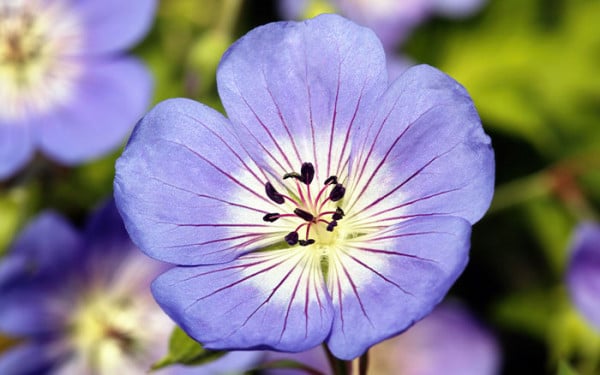You’d expect July to be a month in the garden when everything is in full flower, but sometimes, if a hot June precedes it, the garden takes a break from flowering. Therefore, this can mean there’s not as much happening until August, when the late season flowers start to appear. However, luckily there are plants that will usually be looking great in July. So, here are 10 of the best for this time of the year…
1. Geranium (hardy geranium) ‘Rozanne’
First is a plant that has an incredibly long flowering period, producing a prolific amount of deep blue flowers with a hint of purple for literally months on end. The stems tend to grow ‘long and gangly’, so be sure to give the plant plenty of room to grow and express itself.
- Flowers in summer
- Fully hardy
- Grows to 60cm tall
- Moist but well-drained or well-drained soil
- Full sun or partial shade
- Sheltered or exposed

2. Erigeron karvinskianus (Mexican fleabane)
This is a delightful, low growing plant that, when established, produces masses of small, pink, white daisy flowers for months on end. In a sheltered environment, it’ll retain its small leaves year-round. If it’s happy where it’s growing, it will also self-seed and looks good grown in pots or at the front of a flower border.
- Flowers in summer
- Hardy
- Grows to 15cm tall
- Well-drained soil
- Full sun
- Exposed

3. Helenium ‘Mardi Gras’ (sneezeweed)
Helenium bring a joyful splash of colour to the mid/late summer flower border, producing flowers mainly in fiery shades of yellow, red, and orange. ‘Mardi Gras’ develops into a neat mound shape producing large, yellow daisy shape flowers for weeks on end, turning to orange as they age.
- Flowers in summer
- Fully hardy
- Grows to 75cm tall
- Moist but well-drained soil
- Full sun
- Sheltered or exposed

4. Lavendula angustifolia (lavender) ‘Arctic Snow’
Planting lavender at the edge of a path is the very best way to experience the delightfully aromatic scent given off as you brush past its evergreen leaves on a hot sunny day. Most lavenders have differing shades of purple-coloured flowers but this variety has white flowers. To get the best results, grow it in well-drained soil in full sun and make sure to cut back all the flower stalks after they’ve finished flowering.
- Flowers in summer
- Hardy
- Grows to 50cm tall
- Well-drained soil
- Full sun
- Sheltered

5. Anemone (Japanese anemone) ‘Wild Swan’
Japanese anemones are another very long-lived plant producing many flowers throughout their flowering season which is late summer. This variety is very early to flower and shorter than the average Japanese anemone. It has pretty, large, single white flowers coloured a delicate shade of lilac on the underside. They are well suited to a woodland setting or style garden
- Flowers in summer
- Fully hardy
- Grows to 45cm tall
- Moist but well-drained soil
- Full sun or partial shade
- Sheltered

6. Hebe ‘Paula’
Hebes are another group of easy to care for evergreen plants if you give them a good quality, free-draining soil and an open position. They look great in a mixed border as they provide year-round interest. This variety has large striking pink-purple colour flowers and reddish new growth stems. If you need to prune it, best wait until mid to late spring before doing so.
- Flowers in summer
- Hardy
- Grows to 1m tall
- Moist but well-drained or well-drained soil
- Full sun or partial shade
- Sheltered

7. Argyrocytisus battandieri (Moroccan broom)
Next is a medium size deciduous shrub that looks very exotic when in full bloom. It has silvery-grey leaves and zingy yellow flowers that smell of pineapple, giving it its other common name of the pineapple broom. They grow well in poor soil and look particularly good in courtyard gardens surrounded by Mediterranean style planting.
- Flowers in summer
- Hardy through most areas of the UK
- Grows to 2.75m tall
- Well-drained soil
- Full sun
- Sheltered

8. Betula albosinensis (Chinese red birch) ‘Red Panda’
Birch trees are easy to grow and undemanding. This medium-size variety has a wonderful coppery-pink bark with a white tinge, peeling bark to give it year-round interest. What’s more, it grows into a conical, upright shape, which minimises shade cast elsewhere in the garden. It produces shiny dark green leaves which turn yellow in autumn. Yellow-brown catkins appear in spring. It’s a low maintenance tree that looks great planted as a specimen tree in a lawn where its glowing bark can be best appreciated, especially during the winter months.
- Flowers and catkins in spring
- Fully hardy
- Grows to 9m tall
- Moist but well-drained or well-drained soil
- Full sun or partial shade
- Exposed or sheltered

9. Heuchera (coral bells) ‘Obsidian’
There are hundreds of different cultivars of Heuchera available with leaves coloured, red, lime green, shades of purple, yellow and caramel. They all produce spikes of tiny flowers on generally upright, narrow stems, but are mainly chosen for their dense mound shape leaves. ‘Obsidian’ has almost black leaves forming a neat dome and tiny wisps of cream flowers during the late summer months.
- Flowers in summer
- Fully hardy
- Grows to 60cm tall
- Moist but well-drained soil
- Full sun or partial shade
- Exposed or sheltered

10. Echinops bannaticus (globe thistle) ‘Taplow Blue’
Last but my no means least is a drought tolerant plant that’s long-lived and strikingly architectural when in flower. This easy to grow variety produces pale-blue flowers on long stems from now until September and its leaves have silvery colour undersides. An added bonus is that the flowers attract butterflies and bees.
- Flowers in summer
- Fully hardy
- Grows to 1.2m tall
- Well-drained soil
- Full sun or partial shade
- Exposed


Leave A Comment